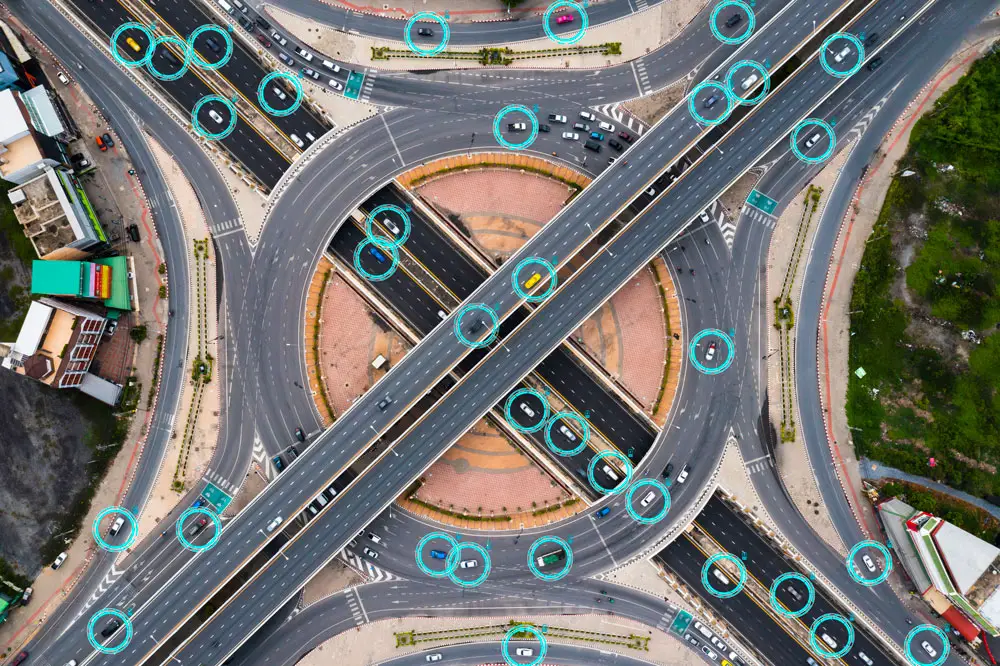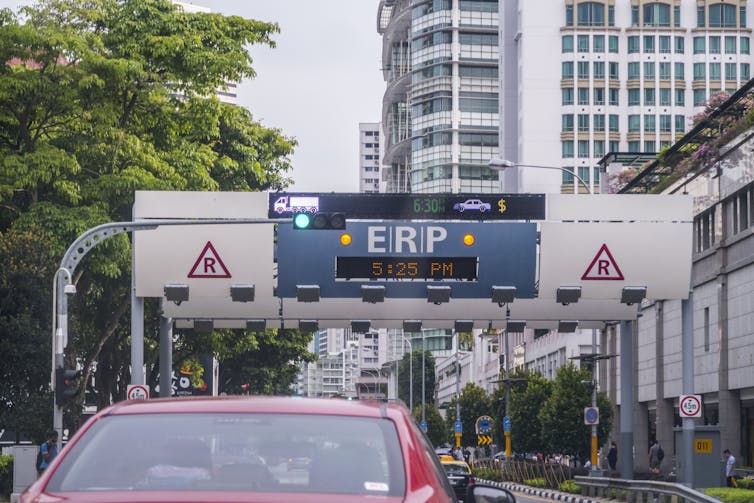
By Giovanni Circella and Scott Hardman
For years, self-driving car technology has remained tantalizingly just beyond the horizon. Bold predictions notwithstanding, fully automated vehicles still haven’t appeared in showrooms. But the technology appears poised for a leap forward in 2022.
Companies including Mercedes-Benz, BMW and Honda are bringing so-called Level 3 AVs to market that will let drivers take their hands off the wheel under specific conditions, and virtually every major auto manufacturer is testing self-driving systems.
Automated vehicles hold tremendous promise. Cars that handle most or all of the driving tasks could be safer than human drivers, operate more efficiently and open up new opportunities for seniors, people with disabilities and others who can’t drive themselves. But while attention has understandably focused on safety, the potential environmental impacts of automated vehicles have largely taken a back seat.
We study automated vehicle technologies and how consumers are likely to use them. In two recent studies, our research teams found two creative ways to assess the real-life impacts that automated vehicles could have on the environment.
By analyzing drivers’ use of partially automated vehicles and simulating the expected impact of future driverless vehicles, we found that both automated vehicle types will encourage a lot more driving. This will increase transportation-related pollution and traffic congestion, unless regulators take steps to make car travel less appealing.
More miles, more carbon emissions
Research has previously suggested that automated vehicles could cause people to drive more than they currently do, leading to more congestion, energy consumption and pollution. Riding in a car as a passenger is much less stressful than driving, so people might be willing to sit through longer trips and battle more traffic if they can relax and do other things during the journey. The promise of a relaxed, comfortable commute to work could even make some people move farther away from their workplaces and accelerate suburban sprawl trends.
People would also have the ability to send their cars on “zero-occupancy” trips, or errands without passengers. For example, if you don’t want to pay for parking downtown, at some point you may be able to send your car back home while you’re at work and summon it when you need it. Convenient, but also twice the driving.
This could be a big problem. The transportation sector is already the leading contributor to U.S. greenhouse gas emissions. States like California with aggressive plans to combat climate change have recognized that reducing the number of vehicles miles that people travel is a critical strategy. What if automated vehicle technology makes it harder to achieve these goals?
The real-world environmental impacts of automated cars
While we and other researchers have predicted these outcomes through modeling, no one has been able to verify them because fully automated vehicles aren’t commercially available yet. We found two innovative ways to use currently available technologies to study the real-world impacts of automated vehicles.
In a study published in mid-2021, we surveyed 940 people who drive partially automated vehicles. Systems like Tesla’s Autopilot can assist with driving tasks and reduce the burden of driving, although to a lesser degree than fully automated vehicles will.
We found that drivers who used Autopilot drove an average of nearly 5,000 more miles per year than those who didn’t. In interviews with 36 drivers of partially automated vehicles, they generally said they were more willing to sit in traffic and took more long-distance trips, all because of the increased comfort and reduced stress provided by semi-automated systems.
In a separate study conducted in late 2019 and early 2020, we simulated the function of a fully automated vehicle by providing 43 households in Sacramento, California, with a chauffeur service to take over the family driving duties and tracking how they used it. These households increased their vehicle miles traveled by 60% over their pre-chauffeur travel, and dramatically reduced their use of transit, bicycling and walking. More than half of the increase in vehicle travel involved sending chauffeurs on zero-occupancy trips without a household member in the car.
Limiting pollution from automated car use
These findings show that automated vehicles will encourage a lot more driving in the future and that partially automated vehicles are doing so now. Is there any way to reap its benefits without making climate change, air quality, and congestion worse?
Requiring future automated vehicles to use zero-emission technology, as California is doing, can be a big help. But until the U.S. develops a 100% carbon-free electricity system, even electric cars will produce some upstream emissions from power generation. And all car travel causes other harmful impacts, such as water and air pollution from brake and tire wear, collisions with wildlife and traffic congestion.
To prevent an explosion in driving and associated harms, regulators and communities need to send signals that driving isn’t free. They could do this by putting a price on car travel – particularly on zero-occupancy trips.
The main policies that have this effect today are federal and state fuel taxes, which currently average around 49 cents per gallon for gasoline and 55 cents per gallon for diesel fuel. But the impact of fuel taxes on drivers’ behavior will decline with the adoption and spread of electric vehicles. This means that the transportation sector will need to develop new funding mechanisms for ongoing costs like maintaining roads.
In place of fuel taxes, state and federal governments could adopt user fees or charges for the number of vehicle miles that drivers travel. Correctly pricing the cost of private vehicle travel could encourage travelers to consider cheaper and more efficient modes, such as public transit, walking and bicycling.
These fees could be adjusted based on location – for example, charging more to drive into dense city centers – or other factors such as time of day, traffic congestion levels, vehicle occupancy and vehicle type. Modern communication technologies can enable such policies by tracking where and when cars are on the roads.

Calvin Chan Wai Meng via Getty Images
Another option would be to promote shared fleets of automated vehicles rather than privately owned ones. We envision these as commercial companies, similar to Uber, Lyft and other ride-sharing providers. Having a car available when needed could make it possible to forgo car ownership and could serve travel demand much more efficiently by essentially acting as on-demand transit. These networks could also help riders reach fixed-route public transportation services that operate on main transportation corridors.
All of these policies will be most effective if they are adopted now, before automated vehicles are widespread. A transportation future that is automated, electric and shared could be environmentally sustainable – but in our view, it’s unlikely to evolve that way on its own.
![]()
Giovanni Circella is Director of the 3 Revolutions Future Mobility Program at the University of California, Davis and Scott Hardman is a Professional Researcher, Plug-in Hybrid & Electric Vehicle Research Center, University of California, Davis.






























Jimbo99 says
All the arguments in the article point to the only solution as fewer people in the world really. Self driving cars aren’t the problem, nor the solution. At the root of the more miles is the fact that more people mean more miles driven and the reason for those trips. Read the articles over any period of recent times, more residential homes & apartments being built under the guise of affordable housing in a booming real estate market & economy where rents are rising too ? Self driving gasoline vehicles ? I thought the trend & future of self driving vehicles is being led by Musk & Tesla.
End of the day here, every accident in Flagler county has involved a human operated vehicle, even the 2 teens that claimed the Tesla was on autopilot were, oh I’ll say it, liars & auto thieves (since their parents claimed they were unaware the teens had taken the vehicle).
https://flaglerlive.com/161956/tesla-deputy-crash/
Mark says
Nothing like more control of our lives by big government to help us lives like a bunch of lemmings.
Barry McDonald says
As a Full self driving autopilot (not really fully self driving and not a very descriptive name) beta tester. I can confirm that having the car just do the driving is pretty great. At first, it was terrifying. The highway autopilot was pretty easy to trust, but the FSD Beta was scary for me. We are more mobile with the car than we were with our last car and we do travel more than pre pandemic travel. We get in the car back out of the driveway and tell (navigate) to our destination. The car does the rest. Do I still have to pay attention? Yes, it’s a beta (trial) and it makes some mistakes ( we have only had minor errors like the wrong speed limit – to the slow side). Also, Palm Coast streets (at least the main ones) could be a lot better maintained for this transportation (areas like Cypress Pointe and PCP have so many lane changes and traffic that I can’t bring myself to let it drive tp Wal-Mart after getting off at 95 from the north). Also, I think our roads (humankind’s) are not ready for this. There are so many places that have their own little quirkiness, that I cannot imagine them ever being standardized enough (think our roundabouts BTW it can do)for full autonomous driving of course then again I never would have thought of every place in the world being on Google Maps (which is really cool in VR). You do realize how horrible people drive when you auto drive. It will be a welcome addition for semi trucks I am sure. Finally, with the Tesla we were driving more before we had the FSD and I am not really sure FSD was worth the $12 K (8K when I bought it) upgrade for me. On the long trips, I am very happy to have it but, just the autopilot may have been enough. I think people drive their Tesla more because they are really fun cars to drive
Progress says
Not sure why you had to single Mr.Klufas. Could be my mistake, but I didn’t see his name anywhere in the article except for the headline.
Did you reach out to him and ask for his opinion on your article ?
I own Tesla. I’ll take you for a ride if you would like.
FlaglerLive says
We singled out Nick Klufas because he has a sense of humor. You might want to reach out to him for pointers. He’s already given us (and many others) a ride in his terrific Tesla.
Michael Cocchiola says
The technology train will not be stopped. We can and should prepare for inevitable advances in transportation as best we can and be flexible enough to solve problems as they arise.